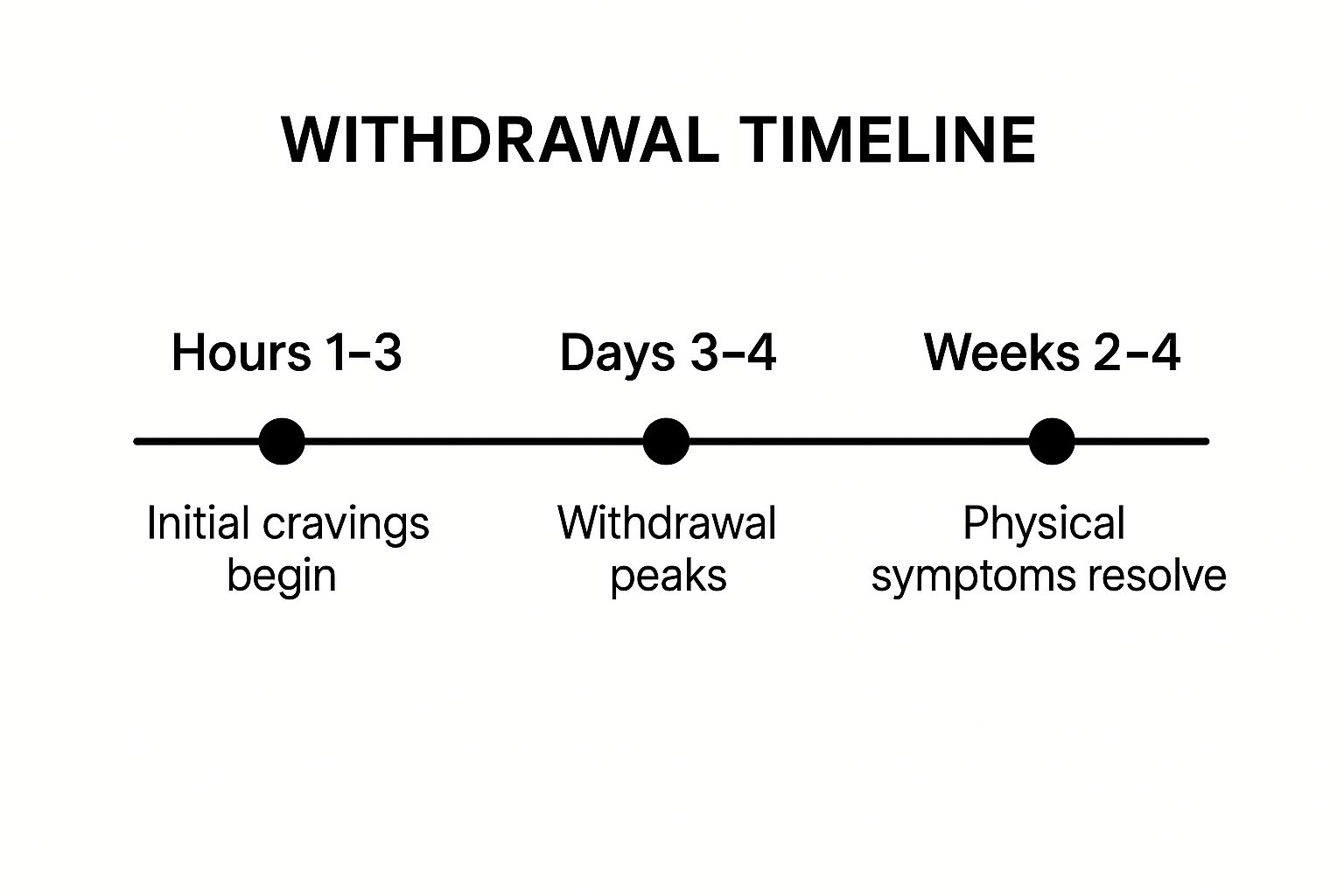Deciding to quit smoking is one of the most significant choices you can make for your health and well-being. While many methods exist, going 'cold turkey'- stopping abruptly without nicotine replacement therapy- remains a popular and powerful strategy. It requires immense willpower, but with the right preparation, it can be the most direct path to a smoke-free life.
This guide is not about generic advice; it is a detailed roadmap filled with actionable quit smoking cold turkey tips designed to navigate the toughest challenges. We will explore how to dismantle your smoking habits, manage intense cravings, and build a resilient mindset for long-term success. You will learn how to set a firm quit date, identify personal triggers, and create new, healthier routines to replace the old ones.
For those seeking support for the physical habit itself, we will also touch on how a nicotine-free alternative like AuraFlow can complement these strategies. It offers a sensory ritual without the addictive chemicals, helping you manage the hand-to-mouth action that so many find hard to break. This comprehensive approach provides the structure and support needed for your journey to breathing easier and reclaiming your health.
1. Set a Firm Quit Date and Destroy All Smoking Paraphernalia
The first and most crucial step in any successful cold turkey journey is creating a clear, non-negotiable starting line. Vague intentions like "I'll quit soon" are easy to postpone. Setting a firm, specific quit date transforms an abstract goal into a concrete commitment. This approach, endorsed by organisations like the American Cancer Society, creates a powerful psychological shift from "smoker" to "non-smoker" on a designated day.

This isn't just about picking a date; it's about preparing for a fundamental lifestyle change. The second part of this step, destroying all paraphernalia, is a critical physical act that reinforces your mental decision. By removing every cigarette, lighter, ashtray, and rolling paper from your home, car, and workplace, you eliminate the immediate triggers and temptations that could derail your efforts in a moment of weakness.
How to Implement This Strategy Effectively
To maximise your chances of success, approach your quit date with a clear plan. This is one of the most foundational quit smoking cold turkey tips because it builds the necessary structure for your journey.
-
Choose Strategically: Select a date within the next two weeks. This is close enough to feel real but gives you enough time to prepare mentally. Avoid choosing a date right before a major holiday, a stressful work deadline, or a big social event where you might be tempted to smoke. A calm, ordinary Tuesday can often be better than a celebratory Saturday.
-
The "Quitting Ceremony": Treat the act of getting rid of your smoking gear as a significant event. Don't just quietly tuck it away; make a ceremony out of it. On the evening before your quit date, gather everything and destroy it. Snap your remaining cigarettes in half, pour water over them, and dispose of everything in an outside bin.
-
Document the Moment: Take a photo or short video of yourself throwing everything away. This can serve as a powerful reminder of your commitment if you feel your resolve wavering later on. It's a tangible piece of evidence that you have chosen a new path.
-
Go Public: Announce your quit date to your friends, family, and supportive colleagues. This external accountability adds a layer of motivation. Saying it out loud makes it more real and enlists your social circle as part of your support system.
2. Identify and Plan for Personal Smoking Triggers
Successfully quitting cold turkey is less about raw willpower and more about smart preparation. A core principle of this preparation, drawn from Cognitive Behavioural Therapy (CBT), involves identifying the specific situations, feelings, and routines that trigger your urge to smoke and creating a pre-planned response for each one. Without a plan, these triggers can automatically lead you back to an old habit before you've had a chance to think.
This proactive strategy shifts you from a reactive position, where you're constantly fighting urges as they appear, to a strategic one. By anticipating high-risk moments, you dismantle their power. The physical act of smoking is often intertwined with deep-seated behavioural patterns, and understanding these is key. By consciously creating new, healthier routines, you can effectively rewire the neural pathways that once led to a cigarette. This is about more than just fighting the physical craving; it's about addressing the psychological habit itself.
How to Implement This Strategy Effectively
Mapping your triggers is one of the most powerful quit smoking cold turkey tips because it arms you with a personalised roadmap for navigating the most difficult moments of your quit journey.
-
Become a Trigger Detective: In the week leading up to your quit date, keep a "smoking diary." Every time you light a cigarette, note the time, your location, what you were doing, and how you were feeling (e.g., stressed, bored, happy). This data will reveal your unique smoking patterns and most powerful triggers.
-
Create a "Trigger Action Plan": Once you've identified your top 5-10 triggers, write them down and assign a specific, non-smoking action to each. For example:
- Trigger: Morning coffee. Action: Brush teeth immediately after the last sip to cleanse your palate.
- Trigger: Driving. Action: Put on a compelling podcast or chew on a piece of sugar-free gum.
- Trigger: Feeling stressed at work. Action: Stand up, do a two-minute stretching routine, and take five deep breaths.
- Trigger: Socialising with drinks. Action: Hold your drink in your dominant hand to keep it occupied.
-
Practice Your New Behaviours: Don't wait until your quit day to try your new coping mechanisms. Practice them beforehand so they feel more natural when the cravings hit. This rehearsal builds confidence and muscle memory for the new, healthier habit.
-
Understand the Habit Loop: Recognising that the challenge extends beyond nicotine to the behavioural habit is crucial. Your action plan is designed to intentionally break the cue-routine-reward loop that keeps smoking ingrained in your life.
3. Use the '4 D's' Strategy for Cravings
Once you've quit, intense nicotine cravings will inevitably strike, often feeling overwhelming. The '4 D's' strategy, popularised by organisations like the NHS and the American Lung Association, is a powerful, in-the-moment toolkit designed to help you ride out these urges without giving in. The core principle is simple: most cravings are powerful but surprisingly short-lived, typically peaking within 3-5 minutes before subsiding. This technique gives you a structured plan to navigate that critical window.

The four D's provide a multi-layered defence: Delay, Deep Breathe, Drink Water, and Do Something Else. By employing these simple actions in sequence or individually, you actively disrupt the craving's hold on your attention, re-centre your mind and body, and successfully wait for the urge to pass naturally. This proactive approach empowers you to manage withdrawal symptoms instead of feeling controlled by them.
How to Implement This Strategy Effectively
Having a pre-rehearsed plan is one of the most effective quit smoking cold turkey tips for handling the physical and psychological pull of nicotine. Instead of panicking when a craving hits, you can immediately pivot to this four-step action plan.
-
Delay: Acknowledge the craving, but consciously tell yourself you will wait just 10 minutes before even considering a cigarette. Set a timer on your phone. This small act puts you back in control and often provides enough time for the most intense part of the urge to fade.
-
Deep Breathe: Step away from your current situation if possible. Practise a simple breathing exercise like the 4-7-8 method: inhale for 4 seconds, hold for 7, and exhale slowly for 8. This calms your nervous system, increases oxygen flow, and mimics the deep inhales associated with smoking.
-
Drink Water: Sip a glass of cold water slowly. This action serves two purposes: it gives your hands and mouth something to do, satisfying the oral fixation, and it helps to flush out toxins and keep you hydrated.
-
Do Something Else: Immediately change your activity and environment. If you're at your desk, get up and walk to another room. If you're at home, start a quick chore like washing the dishes or organising a drawer. This distraction breaks the mental loop of the craving.
For a visual guide on mastering mindful breathing to combat cravings, this video offers excellent techniques:
4. Build a Strong Support Network
Attempting to quit smoking cold turkey in isolation is an unnecessarily difficult battle. Building a robust support network is a strategy championed by countless successful quitters and health organisations because it provides crucial emotional and practical reinforcement when nicotine withdrawal and cravings strike hardest. Informing key people in your life about your decision transforms a private struggle into a shared goal, making you accountable and providing a safety net for tough moments.
This network can include family, friends, colleagues, or even online communities. The principle is simple: humans are social creatures, and sharing a significant challenge makes it more manageable. Whether it's a quick text to a friend during a craving or a weekly meeting with a support group, these interactions remind you that you are not alone and that your goal is achievable.
How to Implement This Strategy Effectively
Creating your support system is one of the most proactive quit smoking cold turkey tips you can follow. It requires actively recruiting your team rather than hoping people will notice your struggle.
-
Be Specific with Your "Ask": Don't just announce you're quitting; tell people exactly how they can help. For example, say, "I'm quitting on Tuesday. If you see me looking stressed, could you offer me a glass of water or suggest we go for a short walk instead of mentioning cigarettes?" This gives them a clear, actionable role. If you want to teach them more, you can share our guide on how to help someone quit smoking.
-
Assemble a Diverse Team: Rely on different people for different needs. You might have one friend who is great for a distracting phone call, a family member who will join you for a smoke-free activity, and an online forum like Reddit's r/stopsmoking for 24/7 anonymous encouragement from others going through the same thing.
-
Schedule Check-ins: Don't wait for a crisis to connect with your network. Arrange for a "quit buddy" to send you a daily good morning text, or schedule a weekly coffee with a friend who has successfully quit. These regular, positive interactions build momentum and normalise your new smoke-free identity.
-
Utilise Professional and Peer Support: Look into formal support systems like local Nicotine Anonymous meetings. These programmes, popularised by their 12-step structure, offer a level of understanding and structured support that can be invaluable, especially in the challenging early weeks.
5. Replace Smoking Habits with Healthy Physical Activities
One of the biggest challenges when quitting cold turkey is dealing with the deeply ingrained physical routines that accompany smoking. Physical activity provides a powerful, healthy substitute for these habits, directly counteracting withdrawal symptoms and cravings. This approach, advocated by wellness experts like Dr. Michael Roizen and integrated into programmes at the Mayo Clinic, repositions your body's need for action into a positive, health-boosting outlet.

When a craving hits, it’s often tied to a specific trigger: a coffee break, finishing a meal, or a moment of stress. By consciously choosing to engage in physical movement instead of reaching for a cigarette, you actively rewire those neural pathways. Exercise releases endorphins, which improve your mood and reduce stress, while also helping to manage the potential weight gain that many people fear when they quit smoking.
How to Implement This Strategy Effectively
Making physical activity an automatic response to cravings is one of the most effective quit smoking cold turkey tips because it replaces a negative behaviour with a positive one.
-
Schedule Your Activity: Pinpoint your most common smoking times and proactively schedule short bursts of activity. If you always smoked on your 10 a.m. coffee break, replace it with a brisk 10-minute walk around the block. If you smoked after dinner, try a 15-minute yoga or stretching session instead.
-
Start Small and Build Momentum: You don't need to commit to a marathon. The goal is to create a new habit. Start with easily achievable activities like five minutes of stretching, climbing a few flights of stairs, or doing a set of press-ups. The key is consistency, not intensity, especially in the first few weeks.
-
Prepare for Any Situation: Keep a pair of trainers in your car or at your desk. Have a list of short, 5-minute exercises you can do anywhere, even in an office or a small space. This removes excuses and ensures you always have a healthy alternative at your fingertips when a craving strikes.
-
Track Your Progress: Use a simple fitness app or a journal to log your activities. Seeing your progress provides a tangible sense of accomplishment and reinforces your new, healthier identity. This creates a positive feedback loop that strengthens your resolve to remain smoke-free.
6. Prepare for and Understand Withdrawal Symptoms
Embarking on a cold turkey journey without understanding what lies ahead is like setting sail without a map. Nicotine withdrawal is a physiological and psychological reality, but knowing what to expect can transform a daunting experience into a manageable process. This approach, championed by cessation experts like Joel Spitzer and supported by research from institutions like Columbia University, emphasises that knowledge is your greatest defence against relapse.
The following infographic illustrates the typical timeline of the most intense physical withdrawal symptoms.

This visualisation highlights a crucial insight: the most severe physical discomfort is temporary and peaks within the first few days before rapidly improving. By understanding this progression, you can frame irritability, anxiety, and cravings not as failures, but as predictable signs that your body is healing. This perspective is one of the most powerful quit smoking cold turkey tips because it empowers you to endure the temporary discomfort with confidence.
How to Implement This Strategy Effectively
Instead of passively waiting for symptoms to strike, take a proactive approach by preparing a personalised withdrawal toolkit. Arming yourself with specific coping mechanisms will help you navigate the challenging first few weeks without feeling overwhelmed.
-
Map the Symptoms: Before your quit date, list the most common withdrawal symptoms: irritability, anxiety, poor concentration, sleep disruption, and increased appetite. Next to each one, write down one or two specific remedies you will use. For example: Irritability = a five-minute breathing exercise; Poor sleep = a cup of chamomile tea and no screens an hour before bed.
-
Keep a Symptom Journal: From day one, briefly log your symptoms and their intensity. This creates a tangible record of your progress. When you feel discouraged on day five, looking back at how severe the cravings were on day three provides powerful proof that you are getting stronger.
-
Prepare Your Environment: Stock your kitchen with healthy snacks like crunchy carrots, seeds, and fruit to tackle oral fixation and increased appetite. Have herbal teas on hand for relaxation and consider over-the-counter remedies like paracetamol for potential headaches.
-
Practise Hourly Reminders: Set an alarm on your phone to go off every hour for the first 72 hours. When it does, take a moment to tell yourself: "This feeling is temporary. It is a sign that my body is healing." This constant reinforcement helps to reframe the struggle as a positive process of recovery.
7. Create New Routines and Reward Systems
A significant part of smoking is the ritual itself: the morning coffee cigarette, the post-meal smoke, or the break-time habit. Successfully quitting cold turkey involves not just overcoming the chemical dependency but also deconstructing these deeply ingrained routines. The key is to consciously replace old smoking-related behaviours with new, healthier, and equally satisfying ones, a principle central to behavioural psychology.
This strategy works by rewiring your brain's reward pathways. Instead of associating pleasure and relief with nicotine, you begin to associate it with new activities and tangible rewards for reaching milestones. This two-pronged approach tackles both the routine and the psychological reward, making the transition to a smoke-free life feel less like a loss and more like a gain.
How to Implement This Strategy Effectively
Building a new structure for your day is one of the most proactive quit smoking cold turkey tips you can implement, as it gives you control when cravings feel overwhelming. For a deeper dive into the science of changing your habits, you can learn more about how to break bad habits and apply those principles here.
-
Map and Replace Your Triggers: Identify the specific times and situations where you would normally smoke. Do you always light up while driving to work? Try listening to an engaging podcast or chewing on sugar-free gum instead. Is your evening routine a cigarette on the porch? Replace it with a calming herbal tea and a chapter of a good book.
-
Design a Tiered Reward System: Your rewards should scale with your achievements. A small, daily pleasure might be enjoying a square of dark chocolate after dinner. For your one-week milestone, treat yourself to a massage or a new film. At one month, use the money you’ve saved on cigarettes to fund a weekend trip or a special dinner out.
-
Calculate and Visualise Your Savings: Use a quitting app or a simple jar to track the money you're no longer spending on smoking. Seeing the funds accumulate provides a powerful, tangible motivator. This pot of money becomes your dedicated "reward fund," making your achievements feel even more earned.
-
Change Your Environment: If your favourite armchair was your primary smoking spot, move it to a different part of the room or change its orientation. Small environmental shifts can help break the powerful mental associations you have with smoking in certain locations.
7 Cold Turkey Quit Smoking Tips Comparison
| Strategy | Implementation Complexity 🔄 | Resource Requirements ⚡ | Expected Outcomes 📊 | Ideal Use Cases 💡 | Key Advantages ⭐ |
|---|---|---|---|---|---|
| Set a Firm Quit Date and Destroy All Smoking Paraphernalia | Medium | Low | Clear commitment, immediate trigger removal | Those ready for abrupt change; prefer no gradual process | Strong psychological commitment; prevents rationalization |
| Identify and Plan for Personal Smoking Triggers | High | Medium (time & effort for self-reflection) | Reduced automatic smoking; builds healthy habits | Individuals aware of triggers; want personalized approach | Highly personalized; addresses root causes |
| Use the '4 D's' Strategy for Cravings | Low | Minimal (water, timer, distraction list) | Short-term craving management | Anytime cravings hit; need quick coping techniques | Easy to remember and apply; versatile and portable |
| Build a Strong Support Network | Medium | Moderate (time, social effort) | Increased success rates; sustained motivation | Those wanting social accountability and peer support | Doubles/triples success rates; reduces isolation |
| Replace Smoking Habits with Healthy Physical Activities | Medium | Moderate (exercise gear/time) | Stress relief, withdrawal symptom alleviation | People seeking healthier lifestyle alongside quitting | Improves health; natural mood enhancement |
| Prepare for and Understand Withdrawal Symptoms | Low-Medium | Low (educational resources) | Better symptom management; reduced anxiety | First-time quitters; those anxious about withdrawal | Increases preparedness; provides realistic expectations |
| Create New Routines and Reward Systems | Medium | Medium (planning, possible expenses) | Habit replacement; motivation through rewards | Those who need structure and positive reinforcement | Builds new non-smoking identity; goal-oriented approach |
Your Next Breath: Embracing a Smoke-Free Future
Quitting smoking cold turkey is a profound act of self-reclamation. Throughout this guide, we've explored a comprehensive toolkit of actionable strategies designed to empower you on this journey. From the foundational step of setting a firm quit date to the tactical deployment of the '4 D's' for managing intense cravings, each tip is a vital component in dismantling the habit for good.
We have seen how crucial it is to identify your personal triggers and proactively plan your response, transforming potential moments of weakness into demonstrations of your strength. Building a robust support network of friends, family, or professionals isn't a sign of weakness; it's a strategic move that provides essential encouragement when you need it most. By consciously replacing the smoking ritual with healthy physical activities and creating new, rewarding routines, you actively rewrite the script of your daily life. Understanding and preparing for nicotine withdrawal symptoms demystifies the process, allowing you to face the physical and psychological challenges with confidence rather than fear.
The most important takeaway is that success isn't about a single, grand gesture. It is built upon a series of small, consistent, and conscious choices you make every single hour of every day. These quit smoking cold turkey tips are not just abstract ideas; they are practical, proven methods for navigating the difficult terrain of addiction and emerging stronger on the other side. Mastering these approaches is valuable because it gives you control, proving that you have the power to reshape your habits and, ultimately, your health.
This journey is a testament to your resilience. Every craving you overcome, every routine you change, and every day you remain smoke-free is a significant victory. You are not just giving something up; you are gaining a future filled with better health, renewed energy, and the profound freedom of being in control of your own wellbeing. Embrace the challenge, trust in your preparation, and look forward to the clear, fresh breath of your new, smoke-free life. It is a future you are building, one conscious decision at a time, and it is entirely within your reach.
Ready to support your journey with a tool that satisfies the hand-to-mouth ritual without the nicotine? Explore how AuraFlow can provide a moment of mindful calm with its natural, plant-powered flavours. Visit AuraFlow to find your perfect companion for a smoke-free future.
